Health and Safety
Asbestos
The term asbestos refers to a family of naturally occurring minerals. These minerals are mined in locations throughout the world including Australia, Canada, South Africa, and Asia. California was formerly a major producer of chrysotile asbestos, and the state rock, Serpentine, often contains asbestos.
Asbestos fibers are small, thin, strong, and resistant to heat and chemicals. These characteristics make asbestos ideal for use in many building materials, including thermal system insulation, floor tiles, roofing materials and surfacing compounds. California regulations define “asbestos-containing construction materials” (ACM) as any manufactured construction material, including structural, mechanical and building material, that contain more than one percent of asbestos by weight. These materials are again classified as either "friable" (crumbly) or "non-friable" (non-crumbly).
The mere presence of undisturbed and non-friable ACM in a building does not present a health hazard. However, exposure to airborne asbestos fibers has been known to cause asbestosis, lung cancer, and other asbestos-related diseases. Asbestos is listed under Proposition 65 of the California Health and Safety Code Sections 25915-25924 as a chemical known to the State of California to cause cancer.The university has abated the areas deemed to be a problem or when an asbestos disturbance is inevitable. Because some buildings on campus were built before the asbestos warning in the 1970s, asbestos was used in many of the products that made their way into these buildings, including floor and ceiling tiles, adhesives, drywall tapes, and roofing materials.
Cal State Monterey Bay continues to improve our campus and part of that improvement includes demolition and remodels. During this process, asbestos-related material may be disturbed or abated. CSUMB will continue to ensure the employees are safe during this process.
- Comprehensive surveys of the ACM in campus buildings and mechanical spaces
- Updated building surveys continue and can be found by visiting our Campus Survey Results on the Google Drive
- Maintenance and repair of building ACM
- Periodic inspections of ACM in buildings
- Abatement of ACM from campus buildings during major alterations and/or demolition projects
- Annual awareness training provided for campus maintenance staff. Employees performing work in areas presumed to contain asbestos-related materials must complete appropriate training. See your supervisor for more information.
- Identification and clean-up of mechanical spaces containing damaged ACM and/or visible debris
- All areas known to be asbestos contaminated are posted and critical barriers are put in place to stop the migration of fibers until permanent repairs can be made
- Annual asbestos notification sent to all employees
- CSUMB Asbestos Management Program
- Comprehensive surveys of the ACM in campus buildings and mechanical spaces
This list of items should not be performed by untrained employees. A Facilities Management work order should be placed for any of the following activities:
- Do not brush or sweep ceilings
- Do not hang or install curtains, drapes, or dividers as they could damage walls
- Do not damage walls while moving furniture or other items
- Do not access areas above the ceilings
- Do not sand floor tiles or backing material
- Do not pin or hang pictures on walls
- Do not drill holes into walls
